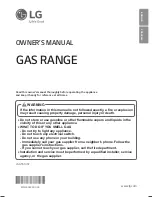
Before Setting Surface Controls
11
Setting Proper Burner Flame Size
Never extend the flame beyond the outer edge of the cooking
utensil. A higher flame wastes energy and increases your risk of
being burned by the flame (
Figure 5
).
The color of the flame is the key to proper burner adjustment. A
good flame is clear, blue and hardly visible in a well-lighted
room. Each cone of flame should be steady and sharp. Adjust
or clean burner if flame is yellow-orange.
Using Proper Cookware
Do not place flammable items such as plastic salt and pepper
shakers, spoon holders or plastic wrappings on the cooktop
when it is in use. These items could melt or ignite. Potholders,
towels or wooden spoons could catch fire if placed too close to
the range cooktop.
Do not place aluminum foil, or any material that can melt on the
cooktop. If these items melt they may damage the cooktop.
For best cooking results, cookware should have flat bottoms
that rest level on the burner grate. Before using cookware,
check for flatness by rotating a ruler across the bottom of the
cookware (
Figure 6
).
Cookware Material Types
The most popular materials available are:
•
Aluminum - Excellent heat conductor. Some types of food
will cause it to darken (Anodized aluminum cookware
resists staining and pitting).
•
Copper - Excellent heat conductor but discolors easily.
•
Stainless - Slow heat conductor with uneven cooking
results. Is durable, easy to clean and resists staining.
•
Cast Iron - A slow heat conductor; however, it will retain
heat very well. Cooks evenly once cooking temperature is
reached.
•
Porcelain
- enamel on metal - Heating characteristics will
vary depending on base material.
•
Glass - Slow heat conductor.
Please note
: The size and type of utensil used and the amount
and type of food being cooked will influence the burner flame
setting needed for best cooking results.
Specialty pans such as lobster pots, griddles and pressure
cookers may be used but must conform to the above recom-
mended cookware requirements.
IMPORTANT!
Never place or straddle a cooking utensil over
two different cooking surface areas heating at the same time.
This can cause uneven heating results.
Figure 5:
How to set flame for efficient cooking
Figure 6:
Check for flat bottom cookware
Correct
flame setting
Incorrect
flame setting
Figure 7:
Cookware recommendations
CORRECT
• Flat bottom
and straight
sides.
• Tight
fitting lids.
• Weight of handle does
not tilt pan. Pan is well
balanced.
• Pan sizes match the
amount of food to be
prepared.
• Made of material that
conducts heat well.
• Easy to clean.
INCORRECT
• Curved and warped pan
bottoms.
• Pan overhangs unit by
more than 1” (2.5 cm).
• Heavy handle tilts pan.
• Flame extends beyond unit.
Содержание E36GF76T
Страница 1: ...Gas Range Use and Care Guide 808638801 Rev A May 2017 ...
Страница 35: ...electrolux com shop ...












































